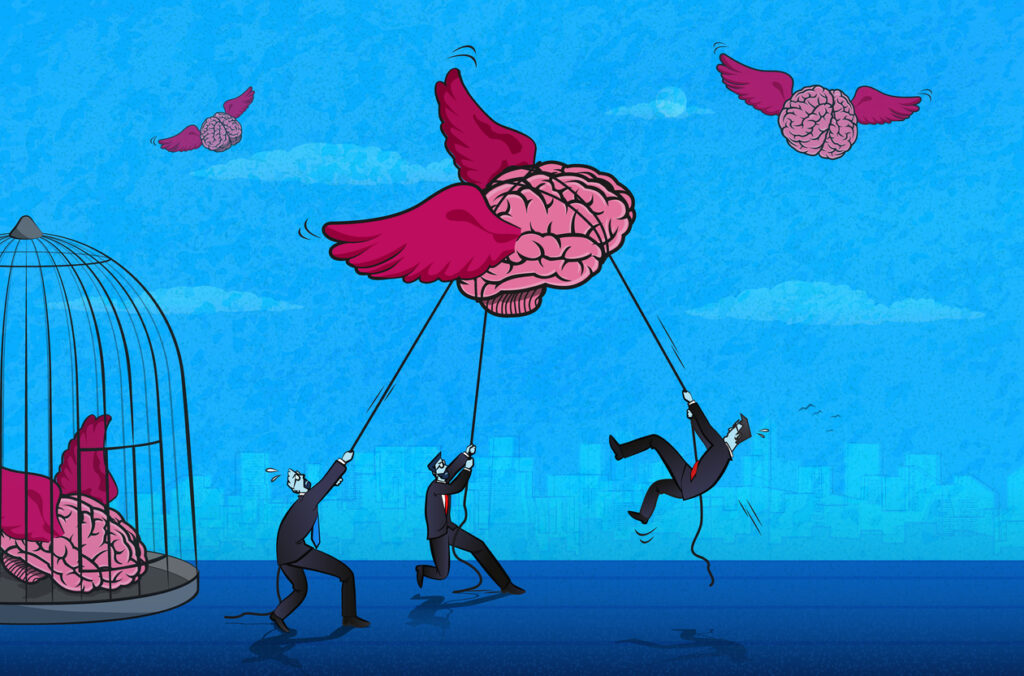Many managers today are stuck in tactical hell, unable to elevate themselves above the daily grind. Perpetually sought out by their teams to resolve complex challenges or to answer questions that their direct reports ought to handle independently. The manager becomes the team’s chief problem solver, ensnared in a dysfunctional cycle that benefits no one.
The costs to organisations can be enormous. Such dynamics stifle the growth of employees, diminish engagement, and ultimately stop leaders from engaging in the strategic thinking vital for anticipating and navigating the many challenges that lie ahead.
If it is so widely recognised as a chronic issue in organisations, why is it so persistent and enduring? And what can leaders do to free themselves from this bind and move from ‘fixer’ to ‘facilitator’?
A ‘blame-not-learn’ culture can predispose certain team members to rely excessively on a manager.
The power dependence cycle
It’s easy for managers to inadvertently create an environment where team members become overly dependent on their approval and problem-solving capabilities. While managers possess a degree of power due to their positional authority and experience, it’s crucial to remember that team members also hold significant influence because of their own skills, expertise and the value they contribute.
Personal traits and a ‘blame-not-learn’ culture can predispose certain team members to rely excessively on a manager for guidance and decisions. This can be intensified if the manager has unclear expectations or inconsistent standards. Ultimately this culminates in a power imbalance, giving rise to an unhealthy dependency.
Decision making goes out the window
Team members, feeling unsure or insecure about proceeding without their manager’s input, can unconsciously prompt their boss to exert more control over decisions and tasks as they become frustrated at the lack of progress.
This in turn erodes team members’ confidence in their own decision-making and deepens their reliance on their manager. As a result, employees may wait for managerial directives instead of acting proactively. They may also settle for delivering lower quality work because they anticipate criticism regardless of how much effort they put in.
The outcome is that team members feel less empowered and accountable and exhibit a decline in initiative. This leads to the manager becoming accustomed to making most decisions, further reinforcing the belief that team members lack the ability or willingness to contribute independently.
Instead of considering contributing factors, the individual is often blamed, often described as lazy or lacking initiative.
In many organisations, we’ve encountered intelligent and capable individuals who have become disempowered individuals.
The trap of learned helplessness
How managers treat those perceived as underperforming or lacking initiative can deeply influence outcomes. Martin Seligman’s theory of Learned Helplessness demonstrated this when test subjects, previously exposed to inescapable electric shocks in a confined space, remained in that space even when they could leave.
Seligman’s research showed that individuals, over time, may come to view their efforts as futile, leading to a self-defeating cycle of inaction and despair.
In many organisations, we’ve encountered intelligent and capable individuals who have become disempowered individuals. They become increasingly dependent on others for decisions and problem solving and often blame external events for their situation rather than taking personal responsibility.
Managers need to cultivate a compassionate attitude towards their team members.
Getting out of the problem-solver trap
Managers should be aware that some employees have a heightened need for validation and approval, even when they know the answer. Leaders play a critical role in bolstering their team’s intrinsic confidence and reducing reliance on external validation.
Managers need to cultivate a compassionate attitude towards their team members and understand that their situation isn’t merely a personal shortcoming. It’s likely due to a complex interplay of various factors, including potentially the manager’s own leadership style.
The goal is to help them regain a sense of control, breaking the cycle of dependence and fostering empowered, self-assured employees.
Encouraging autonomy
Many managers fall into the trap of micromanaging, which fails to promote autonomy. They often struggle to adapt to the demands of a leadership role, relying on a mindset and tactics better suited to a more junior position.
Seduced by the dopamine hit of direct problem solving they overlook that they now create value for the business by enabling others rather than solely through their independent contribution. Consequently, they see taking time out to coach their people and investing time in strategic thinking as indulgent and nebulous rather than vital.
The onus isn’t solely on managers though. Such situations often highlight an organisational shortcoming where there’s a lack of clarity provided to recently promoted managers.
When team members make inevitable mistakes, it’s important to resist the urge to step in and take over or reprimand them.
Managers need to:
- Cultivate autonomy to bolster employee confidence and resilience
- Set clear goals and benchmarks upfront to guide employee performance
- Allowing the work itself, not just the manager’s feedback, to validate employee success
The onus isn’t solely on managers though. Such situations often highlight an organisational shortcoming where there’s a lack of clarity provided to recently promoted managers about the expectations of their role. This can be accentuated by a lack of investment in ensuring they have the skills and support to thrive.
Three next steps for ‘fixer’ managers
Here are three actions your ‘fixer’ managers can take to break the shackles of micro-management and transition to a facilitator role.
1. Foster a culture of recognition
Build a culture where recognition is not solely dependent on managerial validation. Encourage team members to recognise and appreciate each other’s contributions.
2️. Use coaching questions to develop professional judgement
Instead of simply providing the answer to a problem or approving work, focus on using coaching questions to help people critique their own work. You can guide them to assess whether they have delivered good work or not. This means you’re facilitating the solution to the problem rather than fixing it.
3. Set clear expectations
Establish clear goals, objectives and performance expectations with your team members. By defining success criteria upfront, you empower individuals to evaluate their own progress and outcomes.
Looking for more on this topic? Read The HR professional’s guide to handling micromanagers.
[cm_form form_id=’cm_65a14c3f5da64′]






